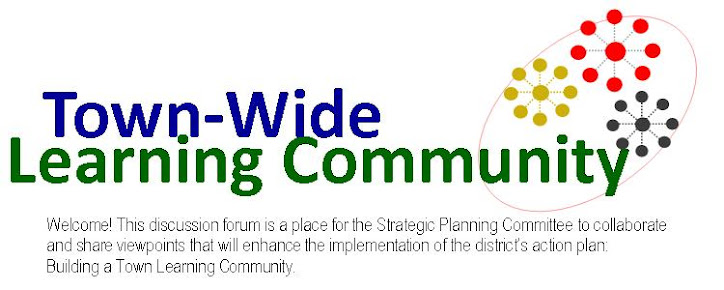The emails from Tom, Rosemary and Lisa about dual enrollment made me realize that its important to have a shared understanding of the common language we are using. I'm hoping this blog can be a place for us to create that shared understanding and keep our dialogue alive, as well as have a repository of the artifacts we find that support our plan.
I'm giving it a jump start by creating a list of references from the the links we created in our strategic plan. Hope you find this useful!

5 comments:
Hi Everyone,
This is my very first blog. I am looking forward to interacting with all of you this way.
Rosemary,
I'm glad to know I'm not the only one who hasn't used this type of forum before. Thanks to Lisa B. I learned how to go to www.blogger.com and build this blog. Now I'm already wondering why I never did this before.
I have reviewed the Education Week article and Executive Summary of the Jobs for the Future Report. I noticed in the appendix of the Jobs report that Smithfield has 32% of their students in dual enrollment. It is far above all of the other districts and it may be interesting to learn more about what and how they do it.
I also think that the "big picture" discussions as part of the strategic plan process is essential in guiding the further development of Cumberland's dual enrollment program. There is a statewide need to align dual enrollment with the P-16 goals. Cross curricular alignment is in our plan.
The Jobs report also points out the need to increase participation by low income students arguing that there will be more incentive to attend college. I think that good instruction, wherever it's offered will entice continued learning.
Finally the Ed Week report paints a bleek picture of the future for dual enrollment. I am hopeful because most districts have some type of dual enrollment effort. These programs have sprouted in increasingly difficult fiscal times. Even with the impending change in administration in two years, there may be opportunities to broaden policy makers' interest. For instance legislators are not currently involved in this discussion and they need to be.
I am interested in hearing what you all think.
It seems like states like Mass & NH are looking beyond the idea of dual enrollment. I have not read the report referenced but would like to as it addresses the competitive nature of our schools.
http://news.yahoo.com/s/time/20081107/us_time/shouldkidsbeabletograduateafter10thgrade
Jumping in here a little late, but it reminded me of some thoughts I had when I first read the email and links....
Duel enrollment is a great idea and should be pursued with rigor. However, one aspect to keep in mind is the impact of our student who completes advanced placement and credits.
I served as an academic counselor for freshman at George Washington Univ and Mary Washington College and worked with many students that arrived to college with advanced courses that waived out of the"101" entry level course and then drowned in the second level course.
College is different, the teachers and expecations are vastly new for many students. Seems that only the rare student can jump a level and be ready, even when they take an actual course.
So while the education and the challenge is vital for engagement at the right level, the springboard ahead could be detrimental down the road. How do we pre-counsel our advanced learners for success once they leave the program????
Post a Comment